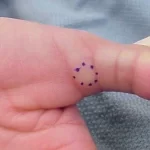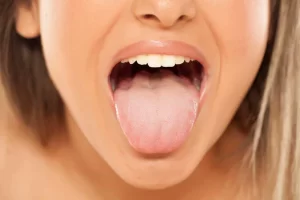Cat’s eye syndrome is a rare chromosomal abnormality in which there are problems in many parts of the body, such as defects of the eyes, ears, anal region, heart, and kidneys. Signs and symptoms are very varied and can include abnormalities of the iris of the eye called “iris colobomas,” which are holes in the iris of the eye that can look like a second pupil or a black slit at the edge of the pupil (this gives the pupil an irregular shape similar to a cat’s eye), markings or depressions in the skin in the region in front of the ears, narrowing or closing of the anal opening (atresia of the anus), heart or kidney defects, and intellectual disability. There may be other problems, such as facial dysmorphia, cleft palate, and developmental delay.Cat-eye syndrome is caused by an extra small chromosome 22 in addition to the two normal copies of chromosome 22. In most cases, there are no other people in the family. The diagnosis of cat eye syndrome is made by studying the chromosomes called a karyotype that shows the presence of the additional chromosome 22. Treatment is based on the symptoms that exist.
Do you have up-to-date information on this condition? We would like to hear from you!
Symptoms
The signs and symptoms are highly variable, and none of the characteristics is always present in those affected. Only 41% of patients with the syndrome present a classic combination of anomalies characterized by coloboma of the iris, anal anomalies, and anomalies in the region in front of the ears (pre-atrial). Signs and symptoms may include:
Ear abnormalities: Low set ears, presence of skin folds in front of the ear (90% of cases), presence of depression in the skin in the region in front of the ear
Eye abnormalities: Coloboma of the retina (the layer that covers the back of the eye that is responsible for vision), present in 50% of cases, increased space between the eyes (hypertelorism) in 50% of cases, cracks eyelid sloping down (50% of cases), iris coloboma (50% of cases), choroidal coloboma (choroid is the middle layer of the eye, which contains blood vessels and connective tissue that nourishes the inner part of the eye), abnormally very small eyes (microphthalmia)
Atresia of the anus
Genital abnormalities: Abnormal communication between the genitalia and the urinary bladder or urogenital fistula (90% of cases), absence of uterus
Kidney abnormalities: small kidneys, abnormal location of the kidney (50% of cases), absence of the kidney
Bone abnormalities: Hip bone abnormalities (50% of cases), rib abnormality (50% of cases), absence of forearm bone (radius)
Cognitive deficit or intellectual disability (50% of cases), which is generally moderate
Poor growth of a baby while in the womb during pregnancy (50% of cases)
Heart malformation (50% of cases)
Decreased muscle tone (50% of cases)
Short stature (50% of cases)There may also be:
Deafness
Absence of the forearm bone (radius)
Biliary atresia (obstruction of the drainage system (biliary tree) from the liver to the intestine)
Cleft palate (cleft palate)
Moderate intellectual disability
Intestinal malrotation (malformation of the intestine that is present at birth in which the parts of the intestine are located in different places than normal because there was a defect during its formation)
Very small jaw (micrognathia)CES presents a broad clinical spectrum in terms of findings and severity, ranging from a normal phenotype to severe multisystem disease. The three main visible features are preauricular abnormalities, anal atresia, and iris coloboma, but none are found consistently. The most common feature is the presence of preauricular pits and skin marks. The typical abnormality of the eye is absent in more than 50% of patients. Coloboma of the eye can affect the iris, choroid, and retina. Unilateral microphthalmia, aniridia, corneal opacity, cataract, and Duane’s anomaly have been observed less frequently. In addition to the preauricular pit and skin appendix, the ears can be low set and very small, with possible atresia of the external auditory canal. Typical facial features include downward sloping palpebral fissures, internal epicanthic folds, hypertelorism, flat nasal bridge, and small jaw. Cleft lip/palate is sometimes seen (see this term). In some individuals, the anal canal is narrow or absent with a desolate fistula.
From the rectum to an abnormal location (bladder, vagina, or perineum). The most frequently described congenital heart defect is a total congenital anomaly of pulmonary venous return and, less frequently, tetralogy of Fallot (see these terms). Congenital kidney abnormalities include the absence of one or both kidneys, hydronephrosis, supernumerary kidneys, and renal hypoplasia. Bone abnormalities include spinal defects and limb malformations. Possible gastrointestinal malformations are biliary atresia, abnormal bowel rotation, and Hirschsprung’s disease (see this term). Other variable features include hernias, cryptorchidism, and hypospadias in men. There may also be other very rare malformations that affect practically all organs. Most patients have mild intellectual disability (although, in some cases, it can be moderate to severe), but a few have normal cognitive development. In some cases, short stature associated with a deficiency of growth hormone is observed.
Etiology
Most patients have small satellite supernumerary chromosomal markers (SMC) that result in a partial 22pter-22q11 tetrasomy. In one-third of the cases, this extra chromosome is present in mosaic. Other cytogenetic abnormalities reported with very low frequency include partial trisomy of chromosome 22 and intrachromosomal triplication of the 22q11 region.
Cause
All people normally have one pair of each chromosome, with a total of 23 pairs of chromosomes in the body’s cells. Each chromosome has a narrowing that divides it into two regions known as the arms of the chromosome: short arm, called “p,” and long arm called “q.”
In cat eye syndrome, there is a small extra chromosome that is composed of a segment of the upper half (ter) of the short arm of chromosome 22 and a small region of the long arm (region q11) of chromosome 22 (that is, 22pter -22q11). This extra chromosome 22 (which can be called the supernumerary satellite marker chromosome) is present three (trisomy) or four times (tetrasomy), more commonly, rather than twice in body cells. Also, in some people, this extra chromosome may only be present in a certain percentage of the body’s cells (mosaicism). Having a mosaic does not necessarily predict milder symptoms.

















Add Comment